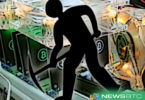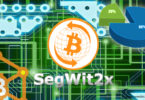Opportunity for President Donald Trump and his new administration. It will come in many shapes, sizes and, yes, even industries. To that end, while there was an enormous focus in 2016 regarding how blockchain, the digital ledger of transactions, is rapidly disrupting the banking industry, opportunities for this technology also exist within the auto, insurance and energy sectors.
This is especially true when you consider that there could be more than 500 billion connected “things” — everything from appliances to self-driving cars and other smart machines — communicating data via the Internet by 2030, according to Cisco Systems.
The blockchain is a shared ledger that can’t be changed or removed in any way unless every single transaction is tampered with, a nearly impossible task. The technology should be of great importance for lawmakers in an age of increased cyber-terrorism threats amid an ever-growing reliance on Big Data and digital information infrastructure.
There’s a great transformative opportunity to retool the power grid, especially as today’s centralized grid supports only a unidirectional flow of power, is dated, is poorly maintained and is very vulnerable to hacking and blackouts. The digitalization taking place in the energy sector will require a higher degree of reliability, efficiency, security and timeliness. This has me excited about the ways that blockchain technology can be integrated into a more decentralized power grid fueled by renewables and Big Data.
“As communities adopt more digital infrastructure, safeguarding it from hacking should be a priority of local governments.”
If there’s truly a commitment to revamp public infrastructure by Team Trump, the elephant in the room needs to be addressed — namely that those 500 billion connected devices can’t realistically be expected to operate on a grid that was never meant for the 21st century. This opens the door for new digital microgrid solutions such as blockchain-backed peer-to-peer energy transactions such as the one piloted by the Brooklyn Microgrid project. (There, neighbors “share” solar power generated by some buildings, but not all of them.)
In a world of Big Data, artificial intelligence, digital twins (virtual representations of processes, services or assets that are stored in the cloud), connected homes, autonomous vehicles, virtual reality, demand response and smart cities, the blockchain could play a critical new role.
Its digital cryptography platform offers an attractive way to “reliably” promote and power clean, intelligent microgrids in ways never before imagined. The blockchain essentially could become the backbone of a more scalable, flexible and communicative power grid, one that supports IP-based, decentralized peer-to-peer energy resources that produce power closer to the source of consumption.
Modern energy technologies such as solar panel installations need modern energy platforms that can transfer energy from one party to the next in order to thrive.
As communities adopt digital infrastructure, safeguarding energy infrastructure from hacking should be a priority of local governments. This makes the blockchain a fascinating platform to tap into considering the power grid was not intended to handle the amounts of connected devices already hitting the market, or the ones yet to come.
Blockchain technology could become the foundation of smart contracts — ones that could be used to help ensure that power generation more closely matches specific demand needs in ways that ultimately create a more efficient transfer of local energy, reduce unplanned power outages by rerouting power when necessary, and bring improvements to the performance of both real and virtual power plants (VPPs), such as those powered by GE.
If there’s truly a commitment to revamp public infrastructure by Team Trump, the elephant in the room needs to be addressed — namely that those 500 billion connected devices can’t realistically be expected to operate on a grid that was never meant for the 21st century. This opens the door for new digital microgrid solutions such as blockchain-backed peer-to-peer energy transactions such as the one piloted by the Brooklyn Microgrid project. (There, neighbors “share” solar power generated by some buildings, but not all of them.)
In a world of Big Data, artificial intelligence, digital twins (virtual representations of processes, services or assets that are stored in the cloud), connected homes, autonomous vehicles, virtual reality, demand response and smart cities, the blockchain could play a critical new role.
Its digital cryptography platform offers an attractive way to “reliably” promote and power clean, intelligent microgrids in ways never before imagined. The blockchain essentially could become the backbone of a more scalable, flexible and communicative power grid, one that supports IP-based, decentralized peer-to-peer energy resources that produce power closer to the source of consumption.
Modern energy technologies such as solar panel installations need modern energy platforms that can transfer energy from one party to the next in order to thrive.
As communities adopt digital infrastructure, safeguarding energy infrastructure from hacking should be a priority of local governments. This makes the blockchain a fascinating platform to tap into considering the power grid was not intended to handle the amounts of connected devices already hitting the market, or the ones yet to come.
“Blockchain technology could become the foundation of smart contracts — ones that could be used to help ensure that power generation more closely matches specific demand needs in ways that ultimately create a more efficient transfer of local energy, reduce unplanned power outages by rerouting power when necessary, and bring improvements to the performance of both real and virtual power plants (VPPs), such as those powered by GE.”
As President Trump goes to work on issues such as U.S. energy independence, I can’t help but imagine a more progressively digitalized world that beckons for a next-generation power grid.
This makes blockchain technology an intriguing digital energy asset that could play a big role in the smart grid of the future by helping to create energy independence and making local energy more efficient right from the power source — something that should further lower reliance on fossil fuels.
At the end of the day, the blockchain may be the key to influencing a major fundamental change in an increasingly digital energy market, exemplified by projects such as the Brooklyn Microgrid owned by LO3 Energy and being tested by partner Siemens. This peer-to-peer energy market will help consumers sell excess power back to the power company or to each other through an exchange that ushers in an era of “transactive” energy — energy that’s even more sustainable because it’s localized, more transparent and more reliable than any other time in human history.
As the Trump administration strategizes over whether the United States should support a strong dollar policy, I’d be remiss not to mention that another way the blockchain could be “utilized” in the energy sector is through authentication of electric vehicle (EV) charging station payment transactions. It could also allow more consumers to use the digital currency bitcoin to pay utility energy bills, a concept being tested in Germany and Japan. Also, in the not too distant future, we may very well see heat from computers used to power heating and air-conditioning for buildings. These generational opportunities could become a reality thanks to a secure grid, one that’s personal and transactive.
The need to create a more resilient and efficient power grid that is local bodes very well for the increased adoption of blockchain technology. This is especially true as we look to create a secure next-generation power grid that reliably can keep up with those 500 billion connected devices and whatever else needs a charge through 2030.
One thing is for sure: these are indeed fascinating times and they require fascinating solutions for personalizing and safeguarding local energy infrastructure. That alone makes blockchain a software power play in the energy sector that could truly help make America great again.
Source: https://www.greenbiz.com/article/500-billion-reasons-blockchain-can-be-power-play







